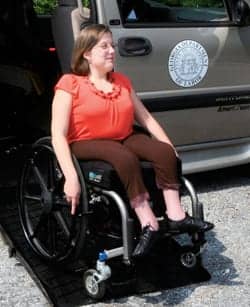Mobility technologies enable users like never before, but only when payors and policy makers say it can. Funding access has become a matter of civil rights.

It is one’s right to access one’s community.
Editor’s Note: Rehab Management is pleased to publish this opinion about the current state of mobility and access funding, contributed by Ann Eubank, LMSW, OTR/L, ATP, vice president of community initiatives, UsersFirst, a program of the United Spinal Association.
As a representative of a consumer organization and an advocate for people who use wheelchairs, I was invited to discuss the latest equipment available to consumers, indubitably a compelling topic.
The good news is that currently there is an extensive offering of excellent products such as lightweight manual wheelchairs that make it possible for some to use a manual wheelchair and decrease shoulder injuries. The market also currently includes wheelchairs and cushions that have the adjustability to provide a custom fit for a person’s physical and functional needs, as well as power wheelchairs with multiple seat functions that allow users to move their bodies in the most healthy and natural way. Available, too, are power wheelchairs with the motor capacity to run all day and negotiate the threshold of a home, and cushions that both provide support and protect the skin. Manufacturers also have designed and produced manual wheelchairs that are easily transferred into a car, and much more. It is a wonderful experience to attend a seating and mobility tradeshow and actually see all that is available. These innovative products allow people to live the lives they choose and provide opportunities for independence so people can participate in their communities. Appropriate products enable most users to go where they want to go: the grocery store, a medical appointment, maybe the hardware store, or, if I may be so bold to suggest, out to dinner.
Most citizens enjoy activities like this every day. And it is one’s right to access one’s community. Yet, when a person uses a wheelchair, these rights are no longer acknowledged. It is not that we haven’t developed innovative products that allow users to gain access. The problem lies with the third-party payors and policy-makers (public and private) who overrule the physician and the clinician’s practice guidelines and clinical judgment by limiting access to products that can greatly enhance the health, function, and quality of life of fellow citizens. We might compare the lack of access to the very equipment that allows Americans to benefit from the equality standards set by the ADA to the Jim Crow laws enacted in the United States from 1876 through 1965.
This statement may seem dramatic, but not to UsersFirst. We receive a host of complaints daily from wheelchair users related to policies that limit their access to equipment that allows them to simply interact with their environments. This is a civil rights issue.
To stop this negative and devastating trend of eroding funding for appropriate seating and wheeled mobility, we must move to embrace both the medical viewpoint and the consumer rights viewpoint. It is essential for clinicians to articulate to the funding source why each aspect of the recommended equipment will enhance the consumer’s function and health and ultimately save health care dollars. The insurance industry is reporting record profits. This is accomplished by reducing health care costs. We at UsersFirst strongly believe the most appropriate seating and wheeled mobility, prescribed by a qualified clinician, will significantly decrease the medical costs related to secondary health issues such as pressure wounds, orthopedic issues, respiratory illnesses, and urinary tract infections.
As a community of people who use, prescribe, make, sell, and repair seating and wheeled mobility products, we must also embrace the consumer rights point of view by supporting the consumer voice. This voice is one that demands equal access to the community, one that believes using a wheelchair should not consign one to becoming homebound or living as if under house arrest. This voice speaks as a consumer, as a citizen who uses a wheelchair. This voice can become even stronger by partnering with all concerned citizens, all people, regardless of diagnosis, who believe Americans should have access to mobility equipment that allows them to live the lives they choose.
UsersFirst strongly encourages all stakeholders (consumers, families, friends, caregivers, clinicians, suppliers, manufacturers) who are touched by these limiting policies to help empower consumers by providing education about policy, invite them to be counted as wheelchair users, and offer resources to help guide them through the service delivery process of seating and wheeled mobility. These actions comprise the mission and goals of UsersFirst. Be part of the movement, get counted, and stay connected at www.usersfirst.org.
Ann Eubank, LMSW, OTR/L, ATP, is vice president of community initiatives, UsersFirst, a program of the United Spinal Association. For more information, contact .




